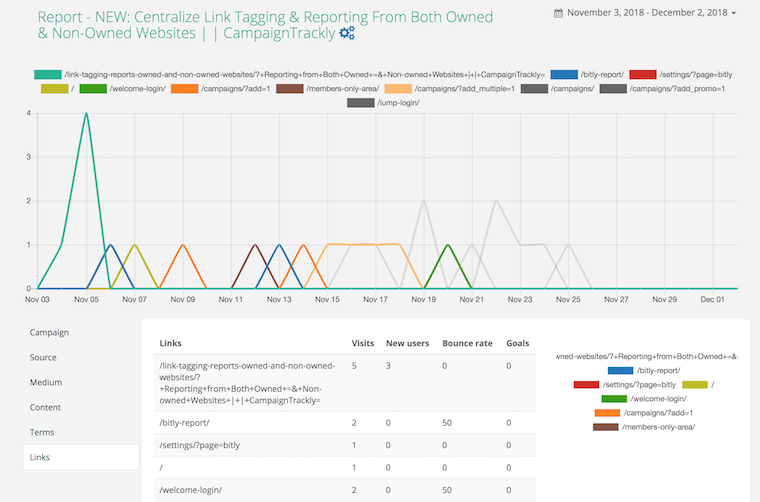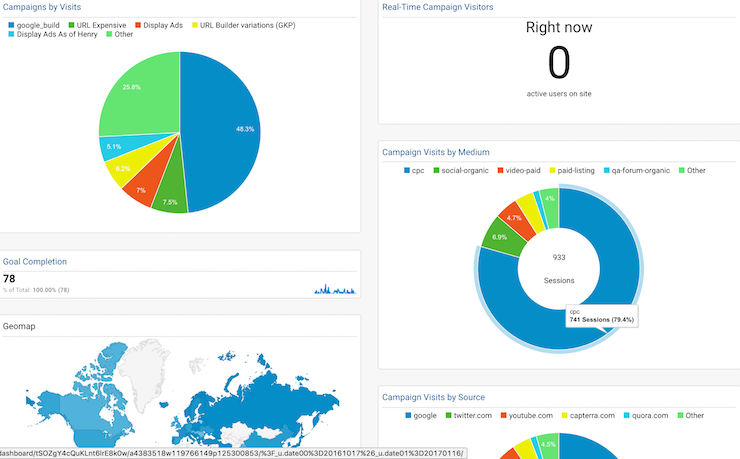

- #Google analytics utm builder how to#
- #Google analytics utm builder generator#
- #Google analytics utm builder code#
Now there’s nothing to stop them stripping the parameters from the URL but you could make it a requirement that they keep the entire trackable link before posting. Using UTM parameters to share URLs with each blogger will help you understand better which contact in your blogging network sends you the most (or best) traffic. And you can’t tell which blogger has the most engaged audience for your content (or which blogger has the best reach). You could give them the bare URL to your post.īut then you won’t know which bloggers and which posts got the most clicks. Let’s say you’re sharing a new blog post with bloggers that will share your content on Facebook. There's no reason for using tagging on links within a website as you can track everything that happens on your website with analytics tools. Use similar forms email_campaign_july, email_campaign_august, for example, to make easier work of managing the results.ĭon’t put tags on internal links on your website. Don’t make up a new campaign naming convention every time you start a new campaign. Add content parameters to help distinguish them like this:īe consistent. You want to know which link gets the most clicks. Let’s say you have a couple of links in an email newsletter that point to the same place. Utm_content – Mostly for paid traffic variations or split tests.īut this tag can also be very useful for tracking different instances of the same link in an email or on a webpage. Utm_term – Generally used by marketers for paid traffic keywords they target in paid search, such as Google Ads or Facebook Ads. Utm_campaign – The campaign name or campaign content Utm_medium – use this tag to identify mediums like ads/CPC, email, guest post, social Utm_source – use this to refer to the traffic source (Google, Facebook, Pinterest)

The auto-tagging feature adds UTM variables to every campaign. Google Ads has an auto-tagging feature within Ads management console. For example, you’ll see that the Referrer source was Facebook. Later, when someone clicks this link you’ll be able to track the movements of the user in Google Analytics.
#Google analytics utm builder code#
If I wanted to share Fat Frog Media’s homepage on Facebook, this would be the URL with UTM code

I try to keep things consistent and avoid using capital letters in the URL. But you should use 3 of the following as a minimum.Įach variant takes a name or phrase to describe it and distinguish the UTM code from other codes.įor example, UTM_source could be Facebook. You also don’t need to add every variant. Here’s an example of two URLs with UTM parameters used for creating trackable links. Especially if you’re trying to keep things consistent.

But it will hamper your tracking efforts. Adding “incorrect” text won’t make the URL unusable. The first thing to know is that you can’t really break the UTM parameters or tags. UTM tracking lets you customize the links you share to better understand which links drive the most traffic. Just know that a UTM parameter or tag is a variable (medium, source, content) you add on to a standard URL. UTM is an acronym for the lovely term Urchin Tracking Module. You can identify the referring website, medium, campaign name, and other terms using what’s called UTM parameters. This part is entirely up to you to decide.
#Google analytics utm builder generator#
Google provides a free trackable link generator tool called the Campaign URL Builder. A better way is to use Google’s tracking URL builder. (Obviously, change the placeholder in square brackets with the names you want to use)ĭon’t use spaces and make sure each parameter is joined by a & symbol.Īfter the URL place the ? Symbol, which indicates to analytics and browsers that anything after that point is a tracking tag or parameter.īut that’s the slow way to do it. URL?utm_source=&utm_medium=&utm_campaign= Just type them out using the protocol below: The best way to track a shared URL on social media, email, websites, and apps is by using a custom URL.Ĭreating tracking URLs manually doesn't require any software. Is Google Analytics the only analytics platform that can understand UTM parameters?.Creating trackable links in Google UTM Builder.
#Google analytics utm builder how to#


 0 kommentar(er)
0 kommentar(er)
